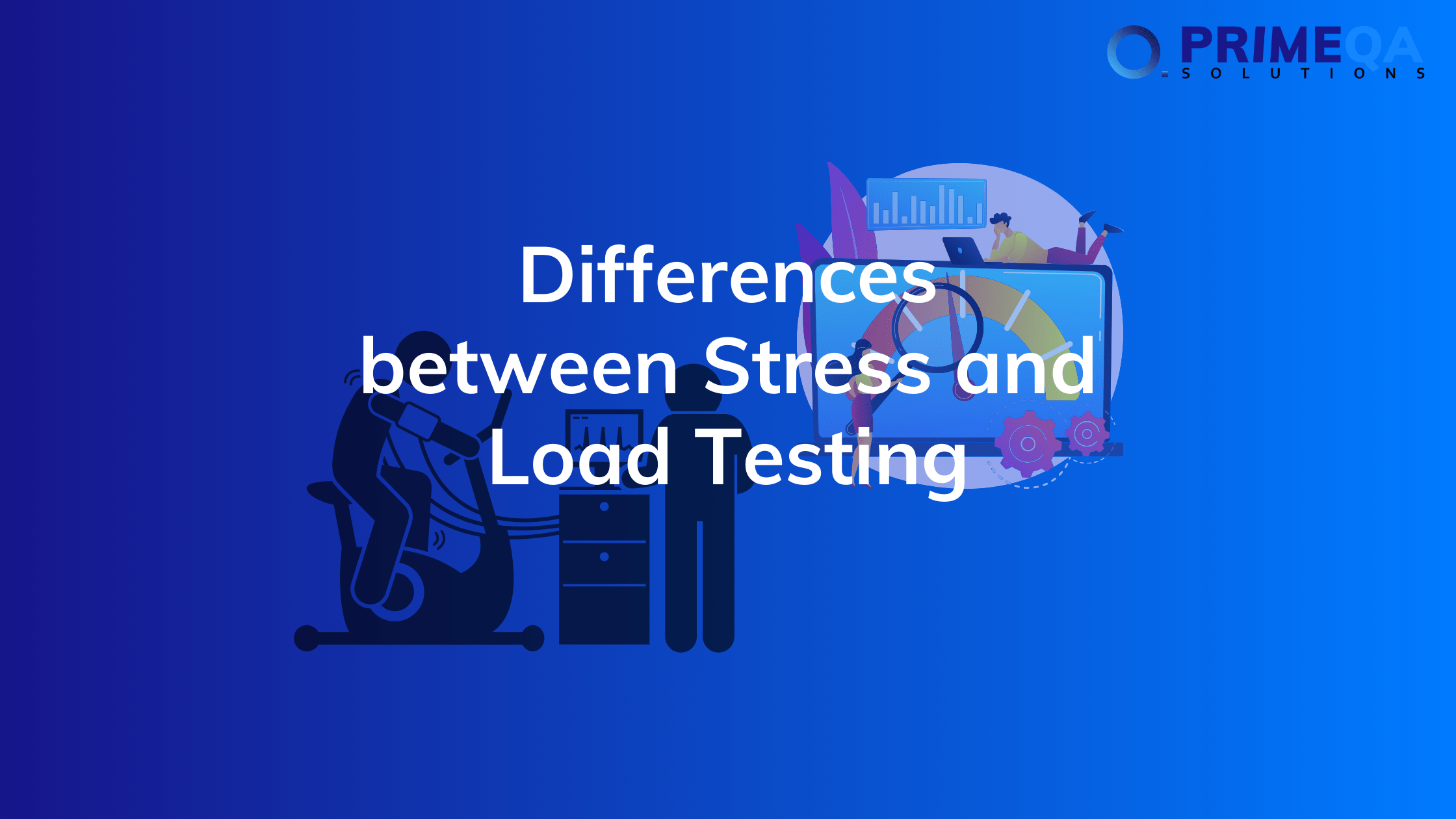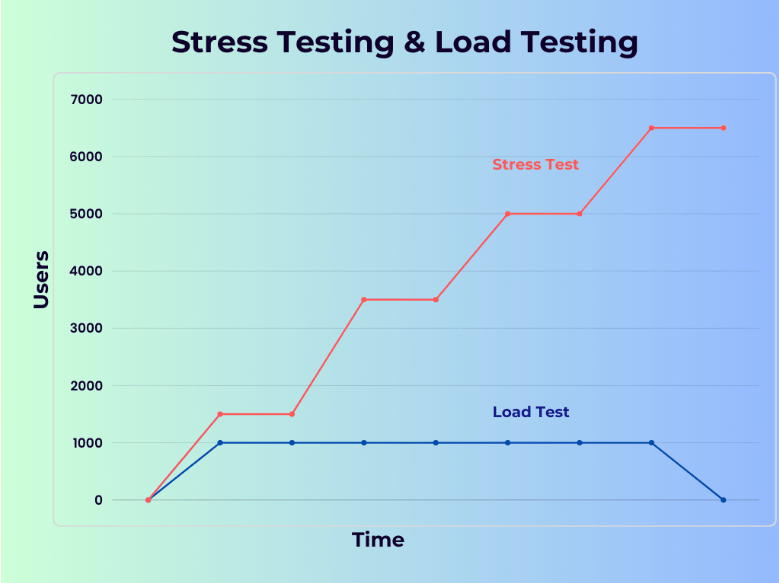In the contemporary world, digital systems need to be sustained under dynamic fluctuation of loads. Both stress testing and load testing are important techniques for testing the performance of an application, even though they serve different functions. This article examines some of the key differences between stress and load testing and, through it, establishes the criticality of both in the success of your program.
Load testing service providers offer efficient services to ensure your applications perform well under a wide array of conditions. For better results, consider partnering with top load testing services to guarantee your systems can handle peak loads efficiently.
Load testing: What is it?
What is load testing? Load testing is a process that tests how an application functions under normal user loads.Load testing uncovers performance bottlenecks by simulating real-world scenarios, ensuring that the system can support normal traffic volumes without degrading user experience.
Important Load Testing Factors:
Objective: To verify that the system works under peak load and normal load.
Scope: To ensure everything works fine under normal use of the system, special attention should be paid to how the system reacts under normal traffic circumstances.
Outcome : you can determine maximum operational capacity, see places of slow performance, and possibly find problems under common use cases.
Stress testing: What is it?
Stress testing is a way to test how an application functions in challenging circumstances. The main purpose of stress testing is to find the breaking point and understand if the application can recover when the system is under stress, causing a significant load.
Key features of a Stress Test:
Objective: To check the system’s strength and capability to recover from the error under high volume scenarios.
Scope: To check the performance of the system under loads that cross the bounds of regular operations, excess traffic, and exceptionally high demand.
Outcome: You will be able to pinpoint system limitations, determine whether the program is capable of doing a self-restart without a crash, and provide guidance on how to handle overloading scenarios.
What Are the main Differences Between Load and Stress Testing ?
Even though it is performance-based testing, load and stress have completely different approaches, goals, and results. Here are the key Differences:
Objective & Goal:
Load testing:
The major purpose of load testing is to ensure that the application efficiently works with the expected number of users. It assesses the performance of the system under the given peak load and the usual functioning settings and checks out for potential performance issues that can cause a degradation of regular user activity. Load testing uncovers performance bottlenecks by simulating real-world scenarios, ensuring that the system can support normal traffic volumes without degrading user experience. By using top load testing services, businesses can ensure their applications perform optimally in real-time performance testing scenarios.
Stress Testing:
Stress testing is the process of determining how robust an application is by subjecting it to severe conditions. To identify the point at which the system breaks down, it is usually stressed beyond normal operational capacities. The test is on the subject’s capability to rebound from that low point and to perform under stress.
Load Conditions :
Load testing: It tries to model the typical user loads over peaks and valleys of traffic. The intention is to mimic real-world situations that the application is likely to encounter in its everyday running.
Stress testing: It applies high loads to the system to actually test it way above its limits many times, even more than peak traffic volumes. This makes it easier to determine how the application responds to sudden increases in traffic and whether it can continue to function in such circumstances.
Focus Areas:
Load testing: Focuses on performance indicators under normal load situations, such as throughput, response time, and resource usage. It contributes to ensuring that when user load rises, the application can scale and keep up its performance.
Stress Testing: Emphasizes robustness under extreme operating conditions, stability, and error handling. It measures the program’s ability to withstand brutal stress relative to data integrity, resource starvation, and recovery strategies.
Outcome and Learnings:
Load testing: This is a view of how the system performs under normal operating conditions. It helps in tracking bottlenecks, making the best allocation of resources, and ensuring that the software offers an error-free user experience in normal conditions.
Stress Testing: This shows the system error-tolerant point or point of failure. It outlines possible defects and weaknesses leading to data loss and/or system failure under high-stress conditions and provides recommendations for increasing strength and resilience.
The Significance of Both Tests
In order to cover a wide range of performance evaluation, both load and stress testing are necessary.Load testing makes sure your application runs without a glitch under regular circumstances to protect the user experience.Your system will be ready for those unexpected, sudden increases in traffic and will be able to withstand hard conditions without experiencing a catastrophic failure at the end of this process.
Conclusion
The difference between load and stress testing is critical for the reliability and improvement of the performance of your application. Stress testing checks if your application is capable of withstanding and recovering from adverse conditions, while load testing verifies if your application can operate efficiently with the expected traffic. The joining of these two can test the Application to give you the best overall evaluation framework that ensures your application will deliver performance and reliability even under the most adverse conditions.
Key Points
- Growing Need for Scalable Systems. With the increasing popularity of cloud computing, mobile apps and the Internet of Things (IoT) there is a demand for systems that can handle varying levels of user activity. This emphasizes the significance of both stress and load testing.
- Emphasis on Security; As cyber threats become more advanced stress testing is essential in identifying vulnerabilities that may surface under certain conditions.
- Rise in Automation; adopting automation tools for stress and load testing is projected to increase simplifying processes and cutting down expenses for us.
Key Facts and Figures:
- Impact of Downtime Costs: Gartner reports that system downtime costs an average of $100,000 per hour based on data. Effective stress and load testing can help prevent disruptions.
- Changing Performance Standards: With users expecting faster response times performance standards for load testing will need to evolve to meet these evolving expectations.
- User Centric Approach: Incorporating real user behavior into load testing will be critical in ensuring a positive user experience, across platforms and devices.
- AI-powered Testing: With the use of artificial intelligence to develop better dynamic and realistic load testing scenarios is acquiring traction. AI can relate real user behavior patterns with better complexity.
- Security through Stress Testing: Stress testing can discover security weaknesses that conventional security testing might miss. It is possible to find and fix vulnerabilities revealed during stress by straining the system to its breaking point.
- Continuous Testing: The concept of “shift-left testing” emphasizes integrating stress and load testing earlier in the development lifecycle. This helps identify and fix performance issues early on, saving time and money.
Remember:
- Stress and load testing are complementary practices, not mutually exclusive.
- The approach towards stress and load testing will vary depending on the system being tested and its intended use.
FAQs
How do load and stress testing contribute to overall system security?
Answer: Load and stress testing contribute to overall system security by identifying vulnerabilities that may be exploited under high load or stress conditions. A software testing & QA services company in India uses these tests to ensure that security measures are robust and can withstand extreme scenarios. This proactive approach helps prevent potential security breaches.
Can we automate load testing?
Answer: Yes, load testing can be automated using tools like Apache JMeter, LoadRunner, and Gatling. Automation allows a software testing company in Ahmedabad to perform repeated and consistent tests efficiently. Automation is a key aspect of modern software testing & QA services, enabling continuous performance monitoring and improvement.
What is the role of monitoring tools in stress testing?
Answer: Monitoring tools play a crucial role in stress testing by providing real-time data on system performance, resource utilization, and potential failure points. These tools help a top software testing company to analyze system behavior under stress and make necessary adjustments. Effective monitoring is essential for comprehensive software QA testing services.
How does load testing impact user experience?
Answer: Load testing impacts user experience by ensuring that the application remains responsive and stable under normal usage conditions. By identifying and addressing performance bottlenecks, a software testing & QA company can enhance user satisfaction and reliability. Load testing is a vital component of delivering high-quality software QA testing services.
What are the differences in test environments for load and stress testing?
Answer: Load testing typically requires an environment that mimics the production setting with expected user loads. Stress testing, on the other hand, requires an environment that can simulate extreme conditions and higher-than-expected loads. A software testing & QA services company in India ensures that both environments are well-configured to provide accurate and meaningful results.
How is the success of load and stress testing measured?
Answer: The success of load testing is measured by the system’s ability to handle expected user loads with acceptable performance metrics such as response time and throughput. We can measure the success of stress testing by identifying the system’s breaking point and its ability to recover from failures. Both tests are essential for the best software testing company to provide reliable software QA testing services.
What are the prerequisites for performing load testing?
Answer: Prerequisites for load testing include a stable test environment, defined performance criteria, realistic user scenarios, and appropriate testing tools. A software testing company in Ahmedabad ensures that these prerequisites are met to conduct effective load testing as part of their software testing & QA services.
When should you consider performing load testing?
Answer: Load testing should be performed during the development and pre-deployment phases to ensure that the application can handle expected user loads. A software testing company in Ahmedabad often integrates load testing into its software testing & QA services to validate performance before the application goes live.
When should you consider performing stress testing?
Answer: Stress testing is typically performed after load testing to evaluate the system’s behavior under extreme conditions. This helps a software testing & QA company to ensure that the application can handle unexpected spikes in usage and recover gracefully from failures. Stress testing is a key part of software QA testing services provided by a top software testing company.
What tools should you consider using for load testing?
Answer: Tools like Apache JMeter, LoadRunner, and Gatling are commonly used for load testing. These tools help a software testing & QA services company in India to simulate user loads and measure system performance. The best software testing company relies on these tools to provide accurate and reliable software testing & QA services.
What tools are the you should consider for stress testing?
Answer: Stress testing tools include Chaos Monkey, Locust, and Tsung. These tools allow a software testing company in Ahmedabad to simulate extreme conditions and evaluate system robustness. They are essential for a software QA testing service to identify potential failure points and ensure system stability under stress.
Why are both load testing and stress testing important?
Answer: Both load testing and stress testing are crucial for ensuring application performance and reliability. Load testing ensures that the application can handle normal traffic, while stress testing evaluates its behavior under extreme conditions. Together, they provide a comprehensive assessment of the system’s performance, which is essential for any software testing & QA company. By incorporating both types of testing, a top software testing company can deliver robust and reliable software testing & QA services.








